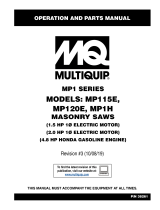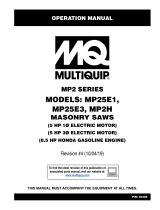Page is loading ...

DIAMOND
P R O D U C T S
Operator’s Manual
Core Cut
MASONRY SAW
MODEL:
CC500M
Part#: 1800739

SAFETY PRECAUTIONS
Note:
Failure to comply with following warnings could
result in serious bodily injury!
1. Read and understand operator’s manual before operating saw.
2. Keep guards in place and in good condition when saw is in operation.
3. Always wear approved ear, eye, head and respiratory protection.
4. Keep all parts of body away from blade and other moving parts. Do not touch or try
to stop a moving blade with your hand.
5. Know how to stop saw quickly in case of emergency.
6. Inspect blade, flanges, guards and arbor shaft for damage before mounting blade.
Verify blade arbor matches the machine arbor.
7. Only use blades marked with a maximum operating speed greater than blade shaft
speed. Read and understand warnings and instructions on the blade. Use the
correct blade for the type of work to be done. If you are unsure, check with the blade
manufacturer.
8. Use caution and follow instructions when transporting, lifting and setting up saw.
Always tie down the machine when transporting.
9. Keep bystanders and animals out of work area. Always keep work area clean, well
lit, and free from safety hazards.
10. Do not use saw or blade if damaged. Do not use a blade that has been dropped.
11. Do not operate saw near combustible material or wear clothing of combustible
material. Sparks from saw could cause fire or explosion.
12. Blade exposure should not exceed 180º.
13. Never leave saw unattended when running.
14. Never operate saw while under influence of drugs or alcohol.
15. Before refueling saws with gas engines, shut off engine and allow it to cool. Do not
smoke while handling fuel. Make sure the gas cap on the saw and fuel can are tight
before starting the saw.
16. Never operate gas engine in enclosed areas without proper ventilation.
17. Establish a training program for all operators of this machine and blade.

OPERATING INSTRUCTIONS
1. Set saw frame on a sturdy, level surface. If using standard legs, insert them in
square tubes under saw frame. Tighten wing screws before allowing frame’s weight
to rest on legs. This will prevent the saw frame from wobbling on the legs, possibly
cocking them in different directions, which will impair saw stability. If using the
optional folding stand, make sure that it is placed on level ground so that saw will not
tilt or fall over. If folding stand has optional wheel kit, make sure that brakes on front
wheels are engaged before placing frame on stand or beginning to saw.
WARNING:
Be certain that saw frame will not tilt or fall over before placing cutting head on
frame or operating saw. Failure to do so may result in bodily injury.
2. Place cutting head on saw frame, lining up recesses in pivot shaft with slots in frame
arms. Make sure flats on pivot shaft are facing upward. Slide T-handle pins through
holes in frame arms across pivot shaft flats to secure cutting head. Hook spring
through eyebolt attached to frame. Rotate cutting head backwards until spring hooks
over shaft welded to side of cutting head. Remove hair pin cotter and flat washer
from end of shaft. Place hole in depth lock over end of shaft, and secure with flat
washer and hair pin cotter. Make sure handle and conveyor cart are clean.
3. To cut wet:
Electric motor - Fill water tub within one inch of top. Place pump in water tub so that
intake is fully submerged at all times. Plug pump into receptacle in motor capacitor
box. Pump will run whenever motor is switched on. Do not allow pump to run dry to
avoid damaging it. Open water valve fully on blade guard, and check water flow
before cutting. Water should flow at 2 - 5 GPM (gallons per minute) to adequately
cool wet cutting blades.
Gas engine - Connect a garden hose to fitting on blade guard. Open water valve fully
before cutting. Water should flow at 2 - 5 GPM (gallon per minute) to adequately
cool wet cutting blades.
4. To cut dry:
Electric motor - Disconnect pump plug from motor outlet while motor is switched OFF.
Close water valve on blade guard.
Gas engine - Close water valve on blade guard. Disconnect garden hose from fitting.
WARNING:
Only cut dry with adequate ventilation and proper respiratory protection.

5. For Saws With Electric Motors:
Connect motor to a properly grounded outlet. Motor may be operated on 115 or 230
volts. Set switch on motor capacitor housing to match desired voltage. Plug on
motor cord must also be changed to match correct voltage.
WARNING:
Always make sure that motor is connected to a properly grounded outlet. Failure
to do so may result in serious bodily injury or death. Do not operate motor on low
voltage. It may cause power loss, overheating, or burn out motor windings.
Check voltage at motor while operating. Comply with all local electrical codes. If
you are unsure, check with an electrician.
Proper voltage is critical for proper motor performance. Extension cords which are too
long and/or too small of a gauge will prevent motor from receiving full voltage. Follow
extension cord recommendations below:
CORD
1.5 HP 2.5 HP
LENGTH 115V 230V 115V 230V
50 FT. #12 #14 #10 #14
75 FT. #12 #14 #10 #14
100 FT. #10 #14 #8 #12
Turn switch to “ON” position to start electric motor. If motor overheats, the manual reset
thermal overload will trip. Turn motor off, wait 5-10 minutes for motor to cool, and push
reset button on capacitor housing. Button clicks to indicate that motor is reset.
For saws with gas engines:
Check engine oil level before starting. Start engine and allow it to warm up according to
engine manual instructions. After engine warms up, all sawing is done at full throttle.
To cut material, either:
a) Pull cutting head down by handle to desired cutting depth. It is best to use the entire
diamond segment height to cut. Tighten handle on depth lock to keep cutting head
at set height.
CAUTION:
Take care not to saw conveyor cart in half. Cutting head pivot range allows
operator to “use up” an abrasive blade, but allows the risk of cutting
conveyor cart.
CAUTION:
Do not allow material being cut to rub against blade flanges. This will damage
them and they will need to replaced.

b) Clamp or hold material firmly against the conveyor cart measuring stop.
CAUTION:
If material being cut is allowed to slip, blade may bind, damaging it. Do not cock,
jam, wedge or twist the blade in the cut. Do not grind on the side of the blade.
c) Push conveyor cart through blade at a reasonable, even rate that allows the blade to
cut efficiently, but doesn’t bog down the engine or overload the motor.
WARNING:
Keep hands and all other body parts away from blade when pushing conveyor cart
through cut, and at all times saw is running.
or plunge cut. . .
a) Clamp or hold material firmly against the conveyor cart measuring stop.
CAUTION:
If material being cut is allowed to slip, blade may bind, damaging it. Do not cock,
jam, wedge, or twist the blade in the cut. Do not grind on the side of the blade.
b) Pull cutting head down by handle and hold, making a few passes with the conveyor
cart, increasing the depth of cut with each pass. Important: Near the end of cut,
slow cart feeding down and slightly hold the cart back.
CAUTION:
If cart is not held back at end of cut, blade may draw material in so fast that blade
damage will occur.
7. When finished sawing, turn motor or engine off. (Note: Allow gas engine to cool
down. See engine manual.)
WARNING:
Never leave saw unattended when running.
MAINTENANCE
1. Clean water tub once a day - twice a day during heavy cutting - and refill with clean
water. If sludge accumulates, it can damage water pump and shorten blade life.
2. Clean saw each night after use. Flush pump and hoses with clean water.
3. Lubricate blade shaft and pivot shaft bearings daily. When cutting dry, grease
bearings once or twice daily. Grease provides an added protective seal for bearings.
Use only premium Lithium 12 based grease, conforming to NLGI grade #2
consistency, without Molybdenum Disulfide. Replace damaged or noisy bearings
immediately. Grease blade shaft bearings while saw is running. Grease bearings at
end of job and before saw is stored.
4. Between jobs or extended periods of storage, clean saw with a wire brush to remove
dried sludge. Clean and thoroughly lubricate all moving parts. Check to make sure
all fasteners are tight.

5. Ensure that extension cord gauge matches its length, as shown in chart. Undersize
extension cords may damage motor. Whenever possible, use 230 volts. Inspect
cord for cuts, knicks, or exposed wires. Replace cord if damaged.
6. If you experience any problems with your electric motor or gas engine, contact
Diamond Products for the nearest Authorized Service Center. If motor or engine is
serviced by an unauthorized service center, the warranty will be voided.
7. When transporting saw, remove cutting head from frame. Vibration during transport
could cause the cutting head to pound in the frame, causing the head to come out of
alignment. Always remove the blade when transporting.
8. Make sure that V-belts are always tensioned properly. Replace worn belts in sets.
9. Slots in cutting head are provided to keep blade aligned horizontally and vertically
with cut line on conveyor cart. Loosen lock nuts on blade shaft bearings and tilt shaft
towards appropriate direction. Tighten lock nuts when blade is properly aligned with
conveyor cart.
10. Blade should mount snugly on arbor. If blade fits loosely on arbor, or if arbor
shoulder is grooved, the inner flange must be replaced. Otherwise, blade life will be
shortened dramatically.
11. Blade flanges must have minimum outside diameter of 3 7/8”. Replace worn flanges
immediately because they can shorten blade life or cause blade to break.
12. Frequently inspect conveyor cart. Replace wood insert and wheels often.
13. Replace bronze bearing in blade guard pivot plate if blade guard does not pivot
properly.
14. Clean air cleaner daily on saws with gas engine. See engine manual for
maintenance instructions.
15. For additional engine care, see engine manual.
ABOUT DIAMOND BLADES
Diamond Products manufactures diamond blades suited for your specific cutting needs -
brick, concrete block, tile, refractory etc. Contact a Diamond Products Customer Service
Representative to help determine what blade is right for your specific needs
at 1-800-321-5336 or 1-800-421-3157.

SPECIFICATIONS
Blade capacity: 14”
Maximum Depth of Cut: 5”
Arbor Size: 1”
Blade drive: Matched set of 2 premium V-belts
Models:
CC515M-E1
Baldor Electric Motor, Spec. #35N301X136G1
1.5 Hp - 1 Phase, Totally Enclosed Fan Cooled
115/230 Volts, 60 Hz
13.4 Amps @ 115V / 6.7 Amps @ 230V
3450 RPM at Motor Output Shaft
2585 RPM at Blade Shaft
CC525M-E1
Baldor Electric Motor, Spec. #35N276X459G1
2.5 Hp - 1 Phase, Totally Enclosed Fan Cooled
115/230 Volts, 60 Hz
21.0 Amps @ 115V / 10.5 Amps @ 230V
3450 RPM at Motor Output Shaft
2585 RPM at Blade Shaft
CC555M-H
Honda Gas Engine, Model #GX160K1
5.5 Hp @ 4000 RPM
Fuel capacity: .95 gallons
Oil capacity: .63 quarts
Air cleaner: Cyclone
3200 RPM at Engine Output Shaft
2400 RPM at Blade Shaft
! WARNING: !
The engine exhaust from this product
contains chemicals known to the
State of California to cause cancer,
birth defects or other reproductive harm.
/






